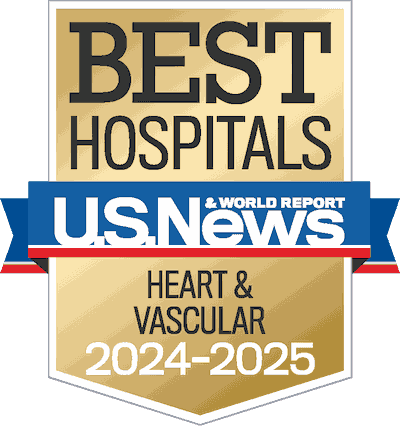What Is Peripheral Vascular Disease?
PVD happens when a buildup of plaque and other substances blocks or narrows blood vessels, limiting or stopping blood flow. “Peripheral” refers to parts of the body that aren’t the heart or brain — often the arms, hands, legs and feet.
The term “peripheral vascular disease” is often used interchangeably with “peripheral artery disease” (PAD). But PAD only applies to the arteries while PVD can also apply to any peripheral lymphatic or blood vessels and veins.
There are many types of PVD, including the following:
- Buerger's disease
- Vascular stenosis
- Chronic venous insufficiency
- Venous thromboembolism
- Deep vein thrombosis
- Raynaud’s phenomenon
- Thrombophlebitis
- Lymphedema
Millions of people in the U.S. are affected by PVD, and while it usually develops in patients 50 years or older, it can come on earlier. Smoking, diabetes and kidney failure are common contributors to the disease.
Many people with PVD don’t have symptoms in the earliest stages of the disease. But when the blood vessels become narrow or occluded, patients can eventually start to feel pain in the extremities, often the legs, especially after physical activity.
Women can also have different symptoms and treatments for many vascular issues. Learn more about how women might experience vascular problems.
When addressed early, many of the effects of PVD can be reduced or stopped. But as the disease progresses, the risks of limb-threatening complications, heart attack or stroke increase.
Peripheral Vascular Disease Treatment at Rush
Peripheral vascular disease, or PVD, can cause pain, limit your mobility or increase your risk for heart attacks and stroke. At more advanced stages, you may even be told that your only options for care will involve complicated surgery or limit your mobility.
That’s why your Rush care team’s first goal is to use noninvasive techniques whenever possible. They’ll help you with lifestyle changes, like quitting smoking, exercising more and sticking to a healthy diet. They’ll also help you with medications and management of other conditions, like heart disease and diabetes, that can affect PVD.
Medications and lifestyle changes can delay or prevent progression of the disease, improve your quality of life and help you avoid or delay procedures and surgeries in many cases.
But even with the best medical care, PVD can progress to stages where you need interventional or surgical treatments. If you need further intervention, your team can offer minimally invasive procedures, surgery and limb preservation services to help you avoid disability.
We work together across many specialties to create a personalized treatment plan for you. Your treatment plan may include one or more of the following:
- Education on diet, exercise and other lifestyle factors that impact PVD.
- Programs to quit smoking.
- Diabetes management.
- Referral to a rehabilitation program for supervised exercise.
- Medications to lower blood pressure and/or cholesterol levels or minimize plaque buildup.
- Minimally invasive interventional therapies to restore blood flow if other management has failed or symptoms have advanced in a way that limits quality of life, including the following:
- Balloon angioplasty, a catheter-based procedure to increase blood flow to the legs using balloons such as intravascular lithotripsy (IVL) for heavily calcified arteries.
- Stenting, permanently implanted scaffolds to keep the artery open.
- Atherectomy, a technique for removing atherosclerosis from blood vessels in select cases.
- Bypass surgery or surgery to remove plaque in complex cases to restore blood flow.

Peripheral Vascular Disease Signs and Symptoms
Many people with PVD don't have symptoms, especially in early stages. Others may mistake symptoms of conditions like arthritis, anemia, spinal stenosis and nerve damage or even normal aches and pains from aging for PVD.
But as the disease progresses, some symptoms may appear. Possible symptoms of PVD include the following:
- Claudication, which is cramping, tiredness or heaviness in the leg muscles, especially during activity, that may go away with rest
- Toes and feet look pale, bluish or discolored
- Leg pain that may wake you up from sleep
- Erectile dysfunction
- Sores or wounds on the toes, feet or legs that heal slowly or not at all
- One leg or foot regularly feeling colder than the other
- Edema, or swelling
- Varicose veins
- Poor nail growth and decreased hair growth over time on the toes or legs
- Gangrene
Peripheral Vascular Disease Diagnosis
Because people with PVD may not experience symptoms in the earliest stages, patients at high risk for the disease should get regular checkups. Early detection and diagnosis can help you avoid major disability, heart attack or stroke.
Many patients with PVD have mild to moderate leg pain as the disease progresses. But leg pain can be a symptom of several other conditions, like arthritis, injuries or normal aging. That’s why it’s important to run diagnostic tests.
One of the tests cardiologists do is a pulse check in both legs. By doing so, they can find out if the pulse in one or both legs has weakened, which can be a sign of PVD.
Some of the other tests cardiologists may perform to diagnose PVD include the following:
- Angiogram: This imaging test relies on a dye injected into the veins or arteries that appears on an X-ray. It helps find any narrowing or blockages of the blood vessels.
- Ankle-brachial index: Also called an ABI, this test compares blood pressure in the ankle and arm with a regular pressure cuff and ultrasound.
Peripheral Vascular Disease Causes
The most common cause of PVD is atherosclerosis, which happens when plaque builds up in the arteries and causes narrowing and restricts blood flow.
Other possible causes of PVD include the following:
- Blood clots
- Diabetes
- Infection, especially salmonellosis and syphilis
- Inflammation of the arteries
- Injury to the arms, legs or blood vessels
- Vascular defects, which can be present at birth
Risks for Peripheral Vascular Disease
There are a few behaviors, characteristics and other conditions that may increase your risk for PVD, including the following:
- Family history of PVD
- Heart and vascular disease
- Hypertension, or high blood pressure
- High cholesterol
- Obesity
- Stroke or “ministroke”
- Diabetes
- Chronic kidney disease
- Smoking
- Sedentary lifestyle
- Age over 50 years old
- Having gone through menopause
Of these, smoking and diabetes create the highest risk because they are known to restrict blood flow.
Peripheral Vascular Disease Prevention
While you cannot control certain risks for PVD, like your age or family history, you can take steps to reduce others and help prevent the disease. For example, you can do the following:
- Stop smoking or do not start.
- Eat a healthy diet.
- Exercise.
- Maintain a healthy weight.
- Control other conditions like diabetes or heart disease with proper medication and treatment.
The main goals of many of these lifestyle changes are to keep you at a healthy weight, reduce your risk of atherosclerosis that can cause PVD and keep your blood pressure, cholesterol and blood glucose at healthy levels.
Choosing Rush for Peripheral Vascular Disease Care
- Care close to home: Rush University Medical Center in Chicago offers comprehensive care to manage symptoms, keep PAD from worsening and reduce future risk. This includes diagnostic testing, a full range of treatments, education, supervised exercise and smoking cessation. But you can also find many of these services at Rush locations around the Chicago area and in Northwest Indiana. You can get Rush’s nationally renowned care without traveling downtown.
- A team approach to care: Your care team’s goal is to provide you with the best and safest care options available. The team includes expert cardiologists, vascular medicine specialists, interventional radiologists and vascular surgeons who work together to explore treatments. They can help enroll you in diet, lifestyle and exercise programs that can slow the progression of disease and assist you with medications. You’ll also have access to limb preservation specialists, when needed, who can help preserve your mobility.
- New treatments from clinical trials: Rush specialists lead the way in PAD research through clinical trials. These trials allow our Vascular Interventional Radiology team to offer new types of care that aren’t available anywhere else, even for patients who've been told they have no other options than major amputation.
Peripheral Vascular Disease FAQs
Peripheral vascular disease will not go away on its own, but it can be reversed with medical intervention. Minimally invasive procedures can open blocked veins and arteries, and surgical treatments can remove plaque from blood vessels. These interventions can restore normal blood flow. Medications and lifestyle changes can also slow the progression of the disease.
Many patients do not have any symptoms in the earliest stages of PVD. But the most common symptom reported in early stages is claudication, which is a cramping of the leg muscles that often appears with physical activity and fades after a period of rest.
PVD is a serious condition that can be fatal if left untreated. It can also lead to stroke, ulceration, gangrene or deep vein thrombosis. Eventually, a limb may need to be amputated. But when caught in early stages and treated quickly, complications of PVD can be reduced or prevented.
Genes may not be a direct cause of PVD, but people with a family history of PVD are at higher risk for developing it. If you have family members with PVD, discuss this with your physician, see a cardiologist for routine testing and take steps to reduce your risks.





